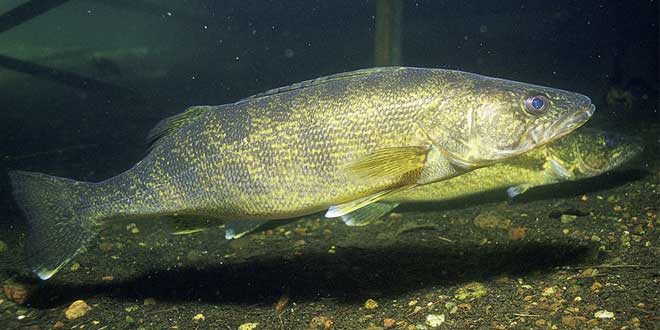LAKE MINDEMOYA—The final results of the Anishinabek/Ontario Fisheries Resources Centre (A/ORC) broad scale monitoring (BSM) fish study on Lake Mindemoya has had a different outcome in terms of the concerns that had been raised in preliminary results on walleye populations and reproduction. The results of the study will be combined with a similar study carried out by the Ministry of Natural Resources (MNR).
“The last time we talked about the BSM fish study, we had preliminary results and there were concerns that there were no young walleye in Lake Mindemoya and there wasn’t much reproduction,” said Keith Nahwegahbow, fisheries technician with A/ORC. However, he said, “through our gauge analysis of the study we have found there are young fish, but they have proven to be very big fish.”
“In one case we found that a 19-year-old walleye was smaller than a three-year-old walleye, which yes, is completely abnormal,” said Mr. Nahwegahbow. “One of the conclusions we have made from our study is that the introduction of rainbow smelts has produced an extra source of food for the walleye, and they are growing fast and are really big.”
“The older walleye have been found to be growing larger but over a much longer period of time,” continued Mr. Nahwegahow. He noted MNR studies are usually carried out every four or five years, so the last studies were carried out around 2009.
“Yes, the final results of our study are more positive than we had originally thought. We thought there had been no reproduction-spawning taking place with walleye and there were no young fish,” said Mr. Nahwegahbow. “The final conclusion of our study is that the lake is in a state of flux. The lake is changing and walleye are changing, although at this point we are not sure to what extent. The water is good and the food source is good. We will just have to wait and see.”
As reported in the September 27, 2013 edition of the Recorder, it was noted that the A/ORC study carried out last summer saw only 66 walleye caught, a low number, with no small fish in the sample. Mr. Nahwegahbow told the Recorder that from the summary of the BSM carried out on Mindemoya Lake August 12 to 23, 2013, a total of 2,380 fish were caught in 40 net sets. The composition is located on the following table: yellow perch, 1,904 caught or 80.50 percent of the total number caught; rock bass, 123 or 5.17 percent; common shiner, 89 or 3.74 percent; walleye, 66 or 2.77 percent; blacknose shiner, 58 or 2.44 percent; smallmouth bass, 52 or 2.18 percent; white sucker, 40 or 1.68 percent; lake whitefish, 20 or 0.84 percent; cisco, 7 or 0.29 percent; log perch, five or 0.21 percent; spot tail shiner, three or 0.13 percent; rainbow smelt, two or 0.08 percent; northern pike, one or 0.04 percent; and fathead minnow, one or 0.04 percent.
The A/ORC study will be combined with an MNR walleye index netting survey last fall. The MNR study will provide additional information and insight into the walleye fishery and will be released by the ministry later this summer.





